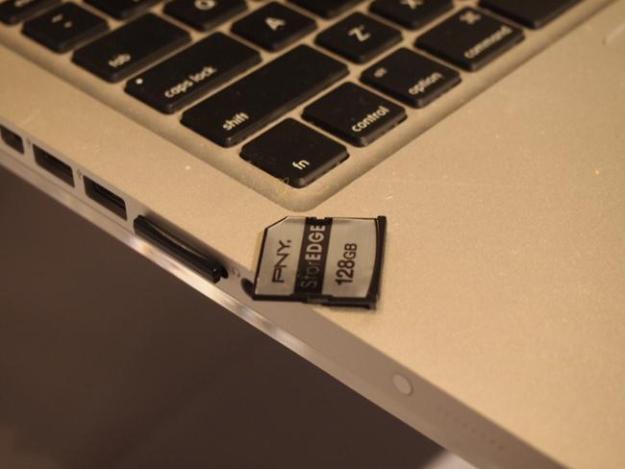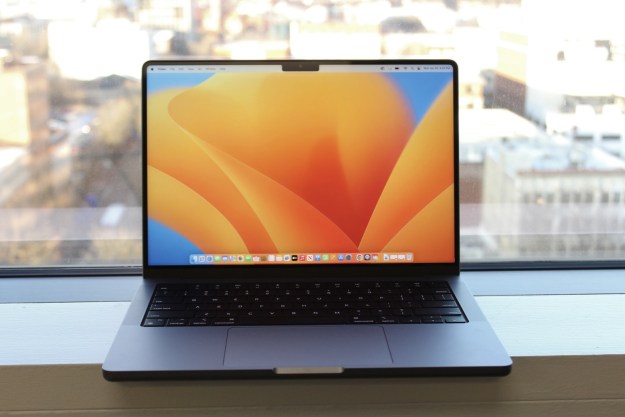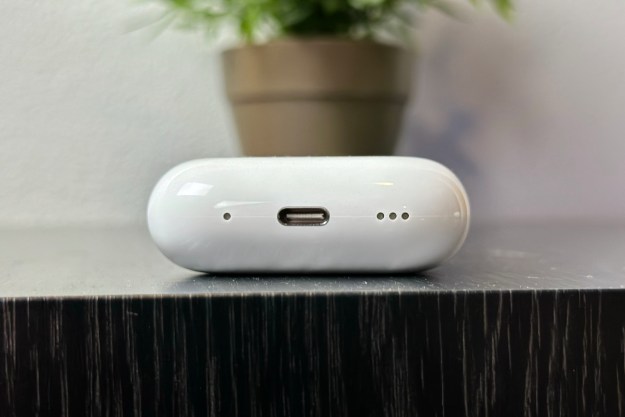
PNY’s StorEdge card looks just like an SD card, but looks may be deceiving Though the StorEdge fits into your MacBook Air or Pro’s SDXC slot, you cannot slide this card into your digital camera. “It is NOT intended for use in cameras; due to the low-profile of the StorEdge,” according to the PNY representative we spoke to. It’s shorter than a full-sized SD Card at 0.95-inch by 0.95-inch, which makes it unsuitable for use in cameras as it could “get stuck in a camera.”
So what is the StorEdge good for? It’s actually designed to expand the storage capacity on MacBook laptops – particularly the first-generation entry-level model with the stingy 64GB solid-state drive – without requiring an appointment at the Genius Bar.

Rather than have all your files spread across multiple, smaller capacity SD cards, or lug around a portable hard drive, you can consolidate all your content onto a single 64GB or 128GB StorEdge card that you pop into your MacBook. As you can see in the photo above, the card shows up as an additional drive on your computer that you can drag and drop files into, and its content is searchable through Finder.

Because the StorEdge is little shorter than a traditional SD card, the card itself barely protrudes from the side of the MacBook – at least on the Pro that was on display at the CEA Line Show in New York City earlier this week. Its slim profile means you can easily pack up your laptop with the card intact, as it’s designed to stay inside your MacBook. Think of the StorEdge as a simple way to upgrade your on-board storage through the SD slot, but without having to open up the guts of your laptop. Just don’t call it a SD card.
Unfortunately, the StorEdge card only works with Macs so PC users won’t be able to expand your SSD through this PNY product, at least according to its website. We reached out to PNY to find out why this is the case, and here is what the company representative told us by email:
This device would NOT work with a non-MacBook. The StorEdge dimensions were built to specifically fit into the MacBook’s slim and sleek SD card slot, as to not protrude. Due to the inconsistency of SD card slots across laptop manufacturers, we cannot guarantee that the StorEdge pins would actually connect in a device other than the MacBook.
MacBook users who want a simple way to expand their SSD’s capacity (sort of) will pay a premium for these PNY cards. The 128GB StorEdge is expected to retail for $200, while the 64Gb will be available for $100. Though the company has yet to formally introduce these StorEdge cards for MacBooks, the PNY reps at the show told us they should land in Best Buy by July 7, followed by the Apple Store in late summer.
[Updated at 8:21am PT on July 2, 2013: Added quotes from PNY representative and included the dimensions of the StorEdge card.]
This post was originally published on June 28, 2013.
Editors' Recommendations
- You can still buy the M1 MacBook Air, and it’s cheaper than ever
- MacBook Pro 16 vs. MacBook Pro 14: The important differences
- The biggest threat to the MacBook this year might come from Apple itself
- Best MacBook deals: Get an Air for $605 and save on M3 MacBook Pro
- The case for buying the M2 MacBook Air over the M3 model


